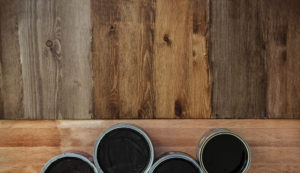
Are you refinishing cabinets or staining a patio at home? Let’s go over the types of wood stain so you can choose the right one for your project. That way, you can confidently take on that project and get exactly the result you want.
Wood stain are liquids and gels designed to color and protect wood. They all include coloring that’s dissolved in a carrier; that carrier can be alcohol, oil, polyurethane or water. Each type of stain has different pro and cans, based on the type of carrier, cleanup and overall ease of use.
Unlike paint, stain isn’t meant to cover the grain — it’s meant to let it shine through. There are several types of wood stain colors, starting with clear, which enhances the natural color of the wood. The hues progress from there and include different wood types (pine, maple, oak, walnut, etc.), plus colors like black and gray.
Interior Versus Exterior Stain
Interior wood stain is made to hold up to interior use (controlled temperatures and light). It also gives a more refined finish than exterior stain. Exterior wood stain isn’t as polished, but it is made to withstand weather.
Types of Wood Stain
Here are the five most popular types of wood stain, including pros/cons and cleanup.
Oil – Oil-based wood stain, made with a linseed-oil carrier, is great because it dries slowly, making it easier to get a smooth finish. It goes on with a rag or brush and penetrates deeply, creating a rich color. Cleanup*: Clean your brush with mineral spirits; let your rag dry then throw** it away.
Water-based – Water-based stains offer excellent protection and color. This quick-dry product can show brush strokes, so you might consider using a rag, instead. This type of stain doesn’t penetrate as deeply as oil-based stains or gels, so you’ll have to apply more coats. Cleanup*: water soluble.
Gel – Unlike oil- and water-based stains, gel doesn’t have to be brushed on. This stain goes on, instead, with a rag. You adjust the color by elbow grease – how hard or soft you rub the gel into the wood. The harder you rub, the darker the stain. Because gels stick better than other types of varnish, they can be used with wood (like pine) that can look blotchy with other stains. Cleanup*: mineral spirits.
Lacquer – Lacquer isn’t a stain — it’s actually a finish that you use with a stain to protect and add shine to the wood. Pros love lacquer because it dries quickly*; if you go this route, spray instead of paint it on for the best finish. Cleanup*: lacquer thinner.
Varnish – Varnish, like lacquer, is a finish rather than a stain. This broad term means any wood finish that dries to a clear film, including, polyurethane, lacquer and shellac. Cleanup*: Based on which product you’re using.
Got wood stain on your mind? Try our deck staining and painting service and see what a difference a new coat of color and protection make for your home. Or, browse trending colors and get free 8″ x 8″ color samples.
*Please refer to the product label, technical data sheet and safety data sheet for detailed safety and application instructions.
**DANGER – RAGS, STEEL WOOL, OR WASTE SOAKED WITH {THIS PRODUCT} MAY SPONTANEOUSLY CATCH FIRE IF IMPROPERLY DISCARDED. IMMEDIATELY AFTER EACH USE, PLACE RAGS, STEEL WOOL, OR WASTE IN A SEALED, WATER-FILLED, METAL CONTAINER